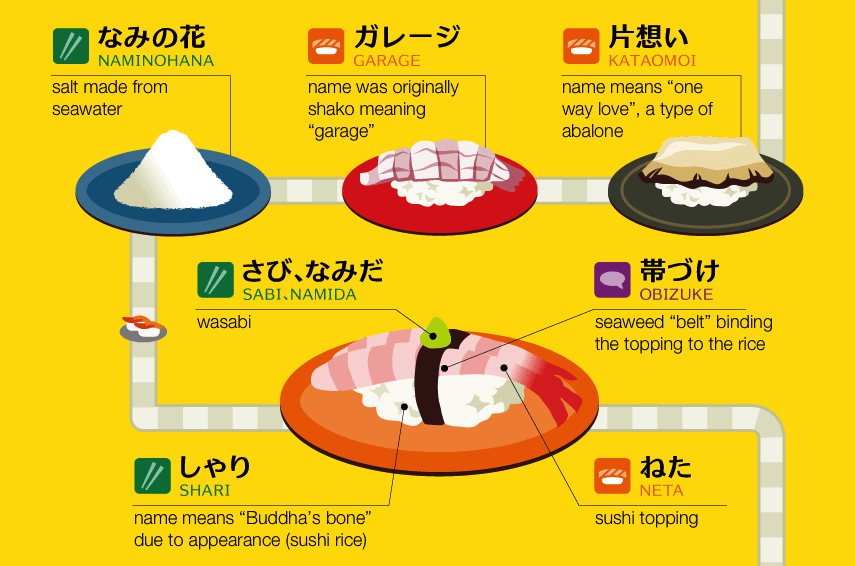If you love sushi then there’s no better place to enjoy it than in its birthplace – Japan. Ordering is pretty straightforward, especially if you go to a sushi train (回転寿司 kaiten-zushi), but if you’re a real fan and want to know some of the terminology used by professional sushi chefs then check out the guide below.

The original infographic was created by Gurunavi (a Japanese restaurant review site) to help people understand the terms that they may not be familiar with. Since it looked so interesting I decided to translate into English with the help of some friends!
Sushi Terminology
- Debana (出ばな) – green tea served at the beginning of the meal
- Murasaki (むらさき) – means ‘purple’, the original colour of soy sauce
- Miyajima (宮島) – rice paddle utensil
- Kataomoi (片思い) – name means “one way love”, a type of abalone
- Garage (ガレージ) – name was originally shako meaning “garage”
- Naminohana (なみの花) – salt made from seawater
- Sabi, Namida (さび、なみだ) – wasabi
- Obizuke (帯づけ) – seaweed “belt” binding the topping to the rice
- Shari (しゃり) – name means “Buddha’s bone” due to appearance (sushi rice)
- Neta (ねた) – sushi topping
- Geso (げそ) – squid legs
- Teppou (鉄砲) – name means “gun” because of similarity to gun barrel
- Gunkanmaki (軍艦巻) – name means “battleship” due to seaweed vessel
- Gari (ガリ) – sliced pickled ginger, used to help cleanse the palate
- Gyoku (ぎょく) – cooked egg sushi (omelette)
- Toro (トロ) – fatty cut of tuna
- Kappa (かっぱ) – cucumber roll
- Himo (ヒモ) – arc shell “red clam”
- Tekkamaki (鉄火巻) – red tuna roll
- Yama (やま) – item sold out
- Nigemono (にげ物) – cheap cut of fish
- Odori (おどり) – live fish
- Agari (あがり) – green tea served at the end of the meal
- Oaiso (お愛想) – polite way for restaurant staff to give the bill/check
Even more on sushifan.com. Found via Sd Japan.


Reply